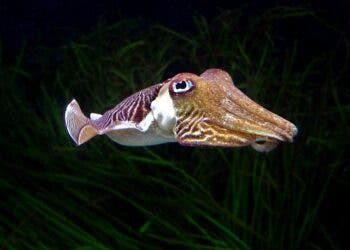
Like a starfish and various other sea-dwelling creatures, the cuttlefish is an invertebrate and not a true fish, for fishes are vertebrates, that is animals which have skulls and segmented spines. However, it does have a solid, bonelike internal shell which aids in buoyancy and is shaped not unlike a half of a clamshell. (A clam is a mollusk as is a cuttlefish.) This shell is called a cuttlebone. Because it is a terrific source of calcium, it has been put in bird cages for pet fowl like canaries since low calcium intakes for birds can lead to brittle bones.
Having eight arms and two tentacles for a total of ten appendages, the cuttlefish is a relative of its fellow cephalopods such as the octopus, squid, and nautilus. (The nautilus is bizarre as its body is equipped with 90 appendages.) Its method of ocean locomotion is attributed to the row of fins outlining the side of its smooth oval-shaped body. Typically growing from six to twenty inches long, the largest of cuttlefish can weigh 23 pounds.
In the wild, cuttlefish seem to be more nocturnal creatures, tending to feed and perform its predatory ambushes at night. Its diet is made up of fish and crabs. In hunting and catching prey, this bizarre marine creature sneaks up on the victim, and when ready it rapidly thrusts its two long, sucker-covered tentacles at the smaller sea creature.
The prey is then pulled toward the cuttlefish mouth. The sharp beak located there comes in handy in breaking the hard shells of animals such as crabs. Evidently considered a dangerous and deceptive little creature, author Jules Verne may have had the submarine Nautilus attacked by a giant cuttlefish in his fantasy novel 20,000 Leagues Under the Sea, depending upon the type of translation from the original French text.
When it comes to a beautiful appearance, the cuttlefish, like squids and octopi, is certainly not lacking. They come in a variety of hues and patterns and are even able to change the color of their bodies to match that of their surroundings. In fact, the illusive cuttlefish is renowned for its superb camouflage capabilities. Special cells on the cuttlefish’s skin called chromatophores allow for extreme alteration of the skin color and texture.

The ancient Phoenicians would dive into the waters of the Mediterranean Sea in order to collect shellfish which were in turn used to acquire a secretion, an element for a violet or crimson dye. The cuttlefish has been used in a similar manner before.
For centuries it has been hunted and desired as it produces a brown pigment from its siphon if startled. In semi-recent times the pigment was still used in sepia ink which was employed by painters. They are now primarily hunted as food. The meat, once thoroughly dried out, is quite edible. Despite its being hunted, this colorful aquatic organism is thankfully not listed as an endangered species at the moment.
On the other side of the spectrum, many people find these creatures rather pleasant due to their natural beauty, smooth movements, and clever camouflaging and keep them as pets. In the United Kingdom and throughout Europe, the common European cuttlefish (Sepia officinalis) is sometimes kept in home aquariums.
But in the United States, there are no native cuttlefish species. One of the most imported species to the US is Sepia bandensis. It often arrives having a size of about four inches and has maybe a few weeks left to live. It is not a recommended pet.
Sources:
- https://www.tonmo.com/pages/Cuttlefish-Basics/
- http://www.ausmepa.org.au/files/cuttlefish_fact_sheet.pdf
- http://www.softschools.com/facts/animals/cuttlefish_facts/2425/






